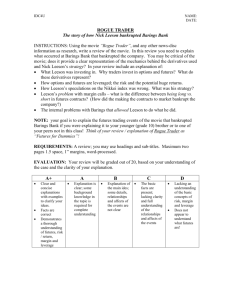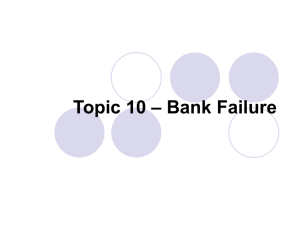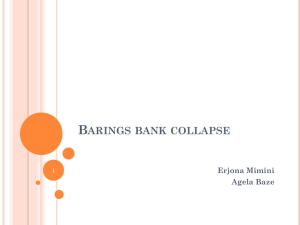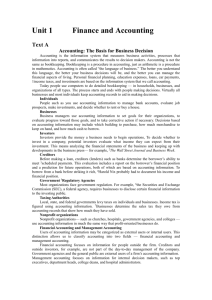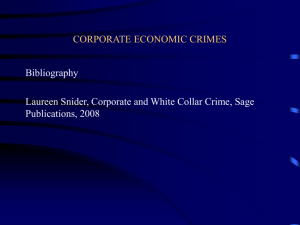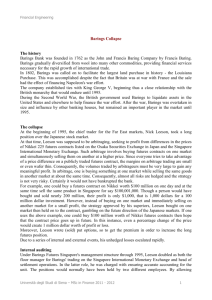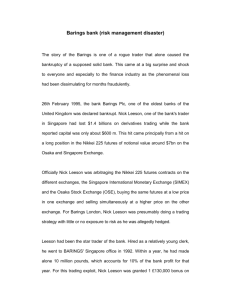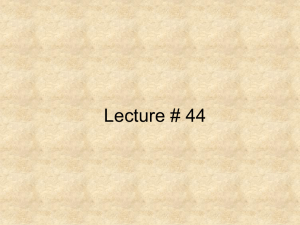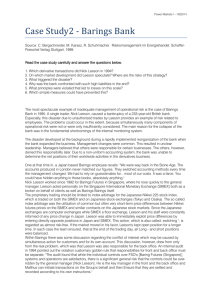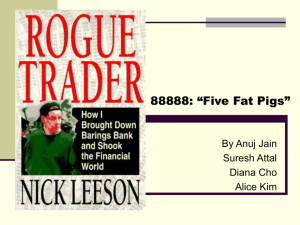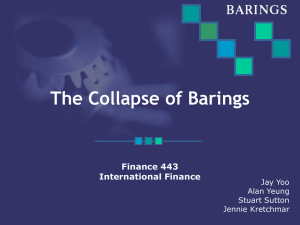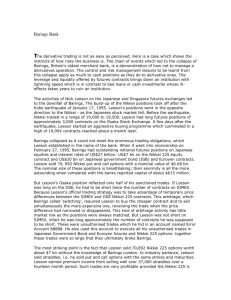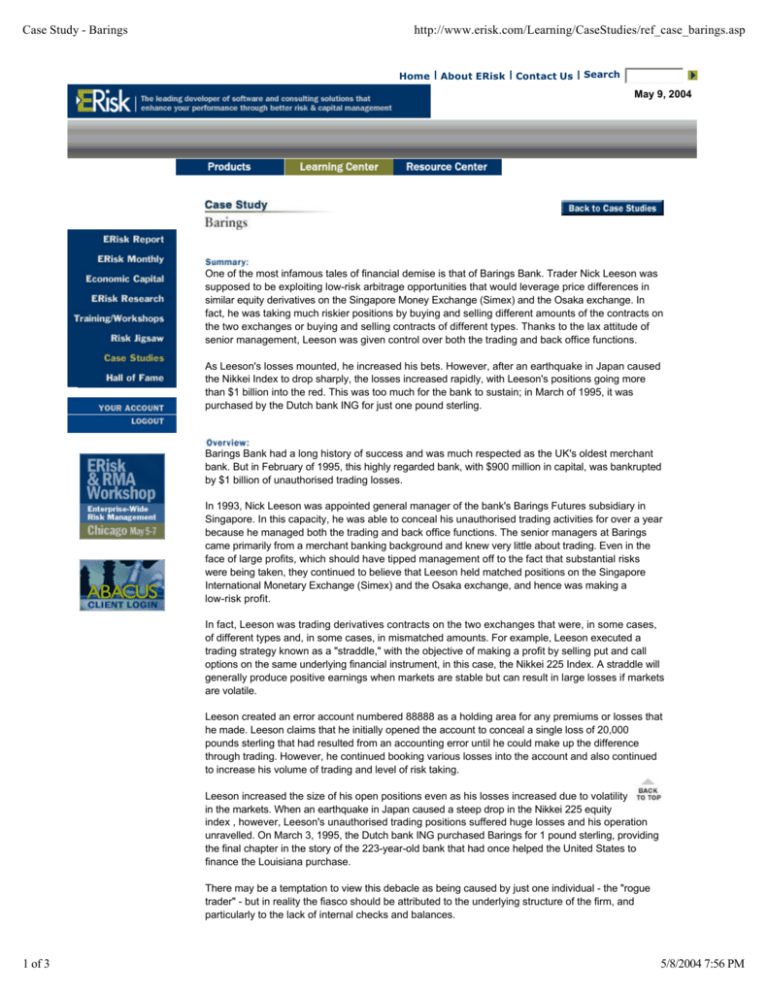
Case Study - Barings
http://www.erisk.com/Learning/CaseStudies/ref_case_barings.asp
Home | About ERisk | Contact Us | Search
May 9, 2004
One of the most infamous tales of financial demise is that of Barings Bank. Trader Nick Leeson was
supposed to be exploiting low-risk arbitrage opportunities that would leverage price differences in
similar equity derivatives on the Singapore Money Exchange (Simex) and the Osaka exchange. In
fact, he was taking much riskier positions by buying and selling different amounts of the contracts on
the two exchanges or buying and selling contracts of different types. Thanks to the lax attitude of
senior management, Leeson was given control over both the trading and back office functions.
As Leeson's losses mounted, he increased his bets. However, after an earthquake in Japan caused
the Nikkei Index to drop sharply, the losses increased rapidly, with Leeson's positions going more
than $1 billion into the red. This was too much for the bank to sustain; in March of 1995, it was
purchased by the Dutch bank ING for just one pound sterling.
Barings Bank had a long history of success and was much respected as the UK's oldest merchant
bank. But in February of 1995, this highly regarded bank, with $900 million in capital, was bankrupted
by $1 billion of unauthorised trading losses.
In 1993, Nick Leeson was appointed general manager of the bank's Barings Futures subsidiary in
Singapore. In this capacity, he was able to conceal his unauthorised trading activities for over a year
because he managed both the trading and back office functions. The senior managers at Barings
came primarily from a merchant banking background and knew very little about trading. Even in the
face of large profits, which should have tipped management off to the fact that substantial risks
were being taken, they continued to believe that Leeson held matched positions on the Singapore
International Monetary Exchange (Simex) and the Osaka exchange, and hence was making a
low-risk profit.
In fact, Leeson was trading derivatives contracts on the two exchanges that were, in some cases,
of different types and, in some cases, in mismatched amounts. For example, Leeson executed a
trading strategy known as a "straddle," with the objective of making a profit by selling put and call
options on the same underlying financial instrument, in this case, the Nikkei 225 Index. A straddle will
generally produce positive earnings when markets are stable but can result in large losses if markets
are volatile.
Leeson created an error account numbered 88888 as a holding area for any premiums or losses that
he made. Leeson claims that he initially opened the account to conceal a single loss of 20,000
pounds sterling that had resulted from an accounting error until he could make up the difference
through trading. However, he continued booking various losses into the account and also continued
to increase his volume of trading and level of risk taking.
Leeson increased the size of his open positions even as his losses increased due to volatility
in the markets. When an earthquake in Japan caused a steep drop in the Nikkei 225 equity
index , however, Leeson's unauthorised trading positions suffered huge losses and his operation
unravelled. On March 3, 1995, the Dutch bank ING purchased Barings for 1 pound sterling, providing
the final chapter in the story of the 223-year-old bank that had once helped the United States to
finance the Louisiana purchase.
There may be a temptation to view this debacle as being caused by just one individual - the "rogue
trader" - but in reality the fiasco should be attributed to the underlying structure of the firm, and
particularly to the lack of internal checks and balances.
1 of 3
5/8/2004 7:56 PM
Case Study - Barings
http://www.erisk.com/Learning/CaseStudies/ref_case_barings.asp
1993: Nick Leeson becomes general manager of Barings Futures (Singapore), running the bank's
Simex (Singapore International Monetary Exchange) activities.
January 1994: By this date (at the latest), Leeson started selling put and call options on the Nikkei 225
equity index, placing the premiums earned into an error account number 88888. This strategy, known
as a straddle, is essentially a bet on the stability of market prices.
24 February 1994: A memorandum from the Barings' asset and liability committee values the options
portfolio at 2.8 billion yen.
July 1994 - August 1994: James Baker, an internal auditor, spends two weeks in Singapore
investigating the immense profits being made there. Baker identifies the weakness of internal controls
and recommends that the general manager should no longer be responsible for the back office. In
response, a separate financial manager in Hong Kong is given part-time responsibility for watching
over the back office.
August 1994: In an attempt to better evaluate its overall risk, Barings sets up an integrated Group
Treasury and Risk function, reporting to a new asset and liability committee (Alco).
December 1994: A later Barings investigation reveals that, for unknown reasons, Leeson has run up
an accrued loss amounting to Y7.7 billion on the account by the end of 1994.
23 January 1995: The Nikkei 225 drops by 1000 points after an earthquake hits Japan's
industrial heartland. Leeson begins purchasing March and June 1995 futures contracts on the
Nikkei.
26 January 1995: The London futures team gives Barings' Alco Committee a presentation on the
Baring Futures (Singapore) operation, which states that Leeson is operating a perfectly matched
book - long in Osaka, but short to the same amount on Simex.
8 February 1995: Coopers & Lybrand decides to hold off signing off on Barings' accounts until it
becomes possible to clear up a few points with Leeson.
23 February 1995: At close of trading, the error account contains 55,399 Nikkei contracts expiring in
March and 5640 expiring in June. As of February 25, this totalled a loss of 59 billion yen on Simex.
24 February 1995: The Barings Board meets to discuss a hastily-prepared analysis of the
transactions in Account 88888.
March 1995: The Dutch Bank ING agrees to purchase Barings for 1 pound and assume all of its
liabilities (Bull, 1995).
2 of 3
5/8/2004 7:56 PM
Case Study - Barings
http://www.erisk.com/Learning/CaseStudies/ref_case_barings.asp
Lessons to be Learned:
Lack of internal checks and balances
Even when segregation of duties was suggested by internal audit, the concentration of power in the
Leeson's hands was scarcely diluted.
Lack of understanding of the business
If Barings' auditors and top management had understood the trading business, they would have
realised that it was not possible for Leeson to be making the profits that he was reporting without
taking on undue risk, and they might have questioned where the money was coming from. Arbitrage
is supposed to be a low risk, and hence low profit, business, so Leeson's large profits should have
inspired alarm rather than praise. Given that arbitrage should be cash-neutral or cash-rich, additional
alarms should have gone off as the Bank wired hundreds of millions of dollars to Singapore.
Poor supervision of employees
Although Leeson had never held a trading license prior to his arrival in Singapore, there was little
oversight of his activities and no individual was directly responsible for monitoring his trading
strategies.
Lack of a clear reporting line
Leeson's fraud may have been facilitated by the confusion caused by two reporting lines: one to
London, for proprietary trading, and another to Tokyo for trading on behalf of customers.
©2004 ERisk. All rights reserved. Legal Information
3 of 3
5/8/2004 7:56 PM

